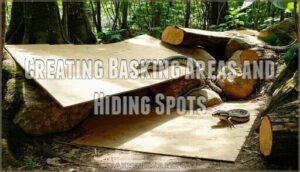This site is supported by our readers. We may earn a commission, at no cost to you, if you purchase through links.
 Creating a snake-friendly environment starts with understanding what these helpful reptiles need.
Creating a snake-friendly environment starts with understanding what these helpful reptiles need.
You’ll want to provide shelter through rock piles, brush heaps, or compost areas where snakes can hide and regulate their temperature.
Add basking spots using flat stones or logs in sunny areas, and maintain water sources like shallow dishes or small ponds.
Plant native vegetation that attracts rodents and insects, creating a natural food chain.
Keep your yard moderately messy – snakes prefer areas with ground cover over perfectly manicured lawns.
Remember, most snakes are beneficial pest controllers that’ll keep your garden free from unwanted rodents.
The key lies in balancing their needs with your comfort level, and understanding that snakes can hide and regulate their temperature in provided shelters, while also being helpful reptiles that create a natural food chain.
Table Of Contents
- Key Takeaways
- Creating a Snake Friendly Yard
- Designing a Reptile Habitat
- Understanding The Benefits of Reptiles
- Identifying Common Snake Species
- Snake Safety and Prevention
- DIY Snake Repellents and Removal
- Encountering a Snake in Your Yard
- Making Your Home Snake Safe
- Snake Conservation and Education
- Maintaining a Snake Friendly Environment
- Frequently Asked Questions (FAQs)
- How do I attract snakes to my garden?
- How do you make a DIY snake habitat?
- How do you keep snakes in your backyard?
- How do you secure a snake’s home?
- How do I choose a snake enclosure?
- Can a snake be a gardener’s best friend?
- How to make a snake friendly?
- What is the best environment for a snake?
- What kind of environment do snakes prefer?
- What is the best habitat for snakes?
- Conclusion
Key Takeaways
- Create shelter options – You’ll need rock piles, brush heaps, and compost areas where snakes can hide and regulate their temperature naturally.
- Provide water and basking spots – Set up shallow water dishes and flat stones in sunny areas to meet snakes’ hydration and thermoregulation needs.
- Plant native vegetation – You’ll attract insects and rodents that create a natural food chain, supporting beneficial pest-controlling snakes.
- Maintain moderate messiness – Keep some ground cover and avoid overly manicured lawns, as snakes prefer areas with natural hiding spots over perfectly groomed spaces.
Creating a Snake Friendly Yard
You can transform your yard into a haven for beneficial snakes by creating the right conditions they need to thrive.
Start with shelter options like rock piles, compost heaps, and fallen logs that provide both hiding spots and warm basking areas for these helpful garden allies, which are beneficial to have in your yard.
Attracting Garter Snakes and Other Reptiles
For attracting garter snakes and other reptiles, focus on creating diverse microhabitats in your yard.
These creatures thrive when you offer varied shelter options and food sources.
Consider these essential features for your snake-friendly environment:
- Native plants that attract insects and small prey animals
- Water features like shallow ponds or birdbaths for hydration
- Organic gardens free from harmful pesticides that poison food sources
- Basking spots using rocks or logs for thermoregulation
- Shelter variety including brush piles and dense ground cover
Providing Shelter and Hiding Spots
Once you’ve attracted reptiles to your yard, they’ll need proper shelter and hiding spots to feel secure.
Creating these snake-friendly environments is like building tiny hotels throughout your landscape.
Here’s what works best:
- Rock pile design with softball-sized stones and natural crevices
- Brush piles using fallen logs, leaves, and twigs for layered protection
- Compost heat retention areas that provide warmth and insect food sources
- Natural material layering with stumps and debris for safe travel routes
These habitats can be enhanced with specialty rock products designed for reptile comfort.
These hiding spots let snakes move freely while staying protected from predators and weather.
Creating a Warm Microclimate
Creating the perfect warm microclimate starts with smart rock placement on south-facing slopes.
Position basking spots using plywood basking areas angled toward morning sun.
Compost location matters—place piles where they’ll heat up naturally.
These basking areas create temperature zones from 85-95°F, turning your snake habitat into a thermal paradise that supports healthy reptile activity year-round.
Planting Heat-Loving Plants
After establishing your warm microclimate, you’ll need heat-loving plants that thrive in these conditions.
These plants create perfect snake habitat by offering both basking spots and shelter.
Smart herb selection makes all the difference:
- Lavender: Excellent sun exposure tolerance and low watering needs make this ideal for microclimate design
- Rosemary: Native plants like this provide year-round snake shelter while warming soil naturally
- Thyme: Creates dense ground cover that supports soil warming around your basking spots
Designing a Reptile Habitat
Creating a proper reptile habitat requires careful attention to three essential elements that mimic nature’s design.
You’ll need to build strategic rock piles for basking, establish reliable water sources, and create safe travel corridors that connect different areas of your garden.
This will help ensure that your reptile habitat is well-designed and functional, providing a healthy environment for your reptiles.
Building Rock Piles and Compost Piles
Rock piles and compost piles form the backbone of effective Rockpile Construction and Habitat Integration. You’ll want softball-sized rocks positioned in sunny spots for ideal snake shelter. Material Selection matters—choose dense stones that retain heat well.
For Compost Heat generation, turn piles regularly in sunny locations. Strategic Pile Placement near water sources maximizes effectiveness.
Creating these outdoor habitats requires understanding species specific needs to promote reptile health.
| Feature | Rock Piles | Compost Piles |
|---|---|---|
| Size | Softball-sized stones | 3-4 feet wide |
| Location | Sunny, near water | Sunny areas only |
| Maintenance | Minimal upkeep | Turn regularly |
Creating Basking Areas and Hiding Spots
Your reptiles need perfect basking areas and hiding spots for a thriving snake habitat.
Position plywood or metal sheets at angles for ideal sun exposure and heat retention. Choose smooth rocks for rock selection that warm quickly.
A suitable platform is essential for thermoregulation.
Create shelter design using logs, leaves, and twigs as material safety priorities. This reptile habitat balance keeps your snakefriendly environment healthy and active.
Providing Water Sources and Travel Routes
After establishing those basking areas and hiding spots, you’ll need to focus on accessible water and safe travel routes for your snake-friendly environment.
Snakes require consistent hydration for drinking and shedding, so ground-level water sources work best to prevent drowning risks.
- Shallow water dishes – Use birdbaths or saucers with gently sloped sides and rocks for easy access
- Natural pathways – Create connected corridors using logs, stones, and thick ground cover for safe passage design
- Strategic placement – Position water sources near shelter areas to support natural movement patterns between resources
Understanding The Benefits of Reptiles
You’ll discover that snakes aren’t just beautiful creatures—they’re powerful allies in maintaining your garden’s health and balance.
These remarkable reptiles serve as natural pest controllers, legally protected species, and essential components of thriving ecosystems.
Pest Control and Soil Health
Your garden becomes a natural battleground where natural predators wage war against unwanted invaders.
Snakes excel at pest control, devouring slugs, insects, and rodents that damage your plants.
They also boost soil health through aeration and nutrient addition, supporting organic practices that maintain ecosystem balance for truly sustainable gardens.
Legal Protection and Conservation
Beyond the pest control benefits, you’re also supporting protected species when you create snake-friendly habitats.
Many snakes face serious threats from habitat preservation challenges and illegal poaching. Conservation laws now protect over 20 U.S. snake species under federal legislation, making community stewardship more important than ever.
Killing snakes is illegal in several states, with strict protections in Maryland for all 27 snake species.
Key conservation considerations:
- Snake legal protection varies by state—some impose $5,000 fines for harming native species
- Habitat loss threatens nearly 40% of snake populations nationwide
- Snake conservation efforts rely heavily on public education and tolerance
- Protected species like Eastern Indigo Snakes benefit from backyard wildlife corridors
Ecological Importance of Reptiles
Snake ecology creates intricate food webs where these ecosystem engineers control pest populations naturally.
You’ll witness biodiversity support as snake populations maintain ecological balance through predator-prey relationships.
Their conservation value extends beyond pest control—they’re essential links in the food chain that sustain healthy ecosystems.
| Ecological Role | Impact on Your Garden |
|---|---|
| Pest Control | Reduces rodents, slugs, insects naturally |
| Food Web Balance | Maintains predator-prey relationships |
| Biodiversity Support | Attracts diverse wildlife species |
| Soil Health | Aeration through movement patterns |
| Conservation Value | Preserves native ecosystem function |
Identifying Common Snake Species
You’ll want to know which snakes are likely visitors to your garden before creating the perfect habitat for them.
Learning to identify common species like garter snakes, rat snakes, and kingsnakes helps you understand their specific needs and appreciate the pest control benefits they bring to your yard.
Garter Snakes and Their Habitat
Garter snake-watchers will find these striped garden allies fascinating creatures with specific habitat needs.
These beneficial reptiles contribute substantially to natural pest control while requiring minimal human intervention.
Here’s what makes garter snakes excellent garden companions:
- Garter Diets include slugs, insects, leeches, and worms – perfect for natural pest management
- Hibernation Needs require shelter from October to April in rock piles or compost areas
- Mating Habits occur immediately after spring emergence, with females producing up to 80 live young
- Garter Identification features distinctive longitudinal stripes running along their bodies
- Regional Variations exist, so research your local species for accurate recognition
You’ll attract these helpful snakes by providing water sources and hiding spots near your snake habitat areas.
Rat Snakes and Their Behavior
Rat snakes excel at climbing habits and burrowing behavior that make them exceptional hunters.
You’ll find these black rat snakes scaling trees and structures with remarkable agility, while their diet preferences focus heavily on rodents like mice and rats.
Their snake behavior shifts from daytime activity in cooler months to nocturnal hunting during summer heat.
Understanding these patterns helps you create ideal snake habitats that accommodate their natural hunting and shelter needs.
They’ve even been observed using human-created light sources to ambush prey.
Kingsnakes and Their Diet
The kingsnake stands out as nature’s ultimate predator, earning its royal title through diverse hunting skills.
These remarkable serpents showcase impressive appetites that benefit your garden ecosystem.
Kingsnake prey includes:
- Rodents and small mammals for primary nutrition
- Lizards and amphibians for dietary variety
- Other snakes, including venomous species
- Bird eggs when accessible
- Insects during juvenile stages
Their nutritional needs require protein-rich snake food every 7-14 days, with digestion process taking several days.
Snake Safety and Prevention
Creating a snake-friendly environment requires balancing safety with conservation, helping you coexist peacefully with these beneficial reptiles.
You’ll need to understand proper landscaping techniques, secure potential entry points, and use effective deterrents to maintain control while protecting both your family and local snake populations, which is crucial for conservation.
Landscaping and Yard Maintenance
Through thoughtful yard maintenance, you’ll create the perfect balance between attracting beneficial snakes while maintaining safety.
Regular organic gardening practices support native plants that naturally encourage wildlife garden development.
Strategic seasonal adjustments help manage both snake attractants and deterrents effectively.
Knowing how to identify common venomous snakes is essential for safety.
| Maintenance Task | Snake-Friendly Approach |
|---|---|
| Lawn Care | Mow regularly but leave natural habitat edges |
| Plant Selection | Choose native plants over exotic varieties |
| Water Features | Install shallow dishes, avoid deep pools |
| Debris Management | Create designated brush piles for shelter |
| Habitat Connectivity | Maintain wildlife corridors between garden areas |
Securing Entry Points and Controlling Food Sources
While building up against unwanted visitors, you’ll want to seal entry points and control food sources that attract snakes. Think of it as snake-proofing your property from the ground up.
Here’s your action plan for keeping snakes where they belong:
- Seal home gaps under doors with weather stripping and door sweeps
- Remove debris like wood piles, leaf heaps, and tall grass where rodents hide
- Deter prey by storing pet food and birdseed in sealed, rodent-proof containers
- Fence installation using hardware cloth buried 6 inches deep around gardens
- Yard inspection monthly to check for new holes or gaps in foundations
- Cover vents and openings with fine mesh to block snakeproof barriers
- Eliminate standing water sources that attract rodents and amphibians
- Monitor rodent activity with traps to reduce the primary snake food source
Using Snake Deterrents and Repellents
After securing entry points and controlling food sources, you can add snake deterrents and repellents as backup protection.
Commercial options like naphthalene-based granules and natural repellents including cinnamon or clove oils offer varying repellent effectiveness. However, homemade repellents often lack scientific backing.
Many homeowners explore options for effective snake control to safeguard their properties. Focus on safe application and remember that habitat modification remains your best long-term solution over chemical snake barrier methods.
DIY Snake Repellents and Removal
While creating a snake-friendly garden often involves attracting these beneficial reptiles, you might occasionally need to manage their presence in certain areas of your property.
Understanding natural deterrents and removal methods helps you maintain the balance between welcoming helpful snakes while keeping them away from high-traffic zones like patios or play areas.
Natural Deterrents and Commercial Products
When you need alternatives to calling professionals, several DIY repellents and commercial products offer varying levels of success.
Natural options include cinnamon and clove oil sprays, which field studies show can repel snakes for 2-3 hours. Commercial snake repellents contain naphthalene or sulfur, reducing snake movement by 10-30% in treated zones.
However, effectiveness drops after rainfall, requiring frequent reapplication for any long-term solutions.
Remember these emotional truths about snake deterrents:
- Peace of mind matters – even partial protection helps you feel safer in your yard
- Small victories count – reducing snake activity by 25% still makes a meaningful difference
- Your effort shows care – taking action demonstrates love for your family’s safety
Effectiveness and Precautions
DIY snake deterrents pack some punch, but don’t expect miracles. Natural options like cinnamon oil show mixed results, while commercial repellents offer better consistency.
Always prioritize deterrent safety around pets and children. This is crucial to ensure the well-being of both humans and animals in the vicinity.
| Method | Effectiveness | Safety Considerations |
|---|---|---|
| Essential oils | Low-moderate | Pet toxicity risk |
| Commercial sprays | Moderate | Follow label instructions |
| Physical barriers | High | Proper installation needed |
| Habitat modification | High | Long-term commitment required |
| Professional removal | Highest | Guarantees safe relocation |
Monitor your habitat regularly after applying any snake deterrents or repellents. Some methods may harm beneficial wildlife, so responsible interaction means weighing snake removal against ecosystem balance. This balance is key to maintaining a healthy environment.
Alternative Solutions and Professional Help
When DIY methods fall short, professional snake removal services with licensed handlers offer humane relocation using specialized snake trap devices.
Expert consultation helps identify species and assess snake relocation costs. Many services provide emergency services and connect with snake sanctuaries for proper care.
Protective gear is essential when dealing with snakes. Professional trapping guarantees everyone’s safety while protecting these beneficial creatures.
Encountering a Snake in Your Yard
When you find a snake in your yard, stay calm and don’t panic – most snakes are harmless and more scared of you than you’re of them.
Keep your distance, identify the species if possible, and avoid any sudden movements that might startle the snake, as most snakes are harmless.
Staying Calm and Identifying The Snake
When you suddenly spot a snake, your natural fear response kicks in, but staying calm helps with proper snake identification.
Take a deep breath and observe from a safe distance to determine if it’s non-venomous.
Here’s your snake ID checklist:
- Note the head shape – triangular heads often indicate venomous species
- Check body patterns – stripes, bands, or solid colors aid identification
- Observe behavior – aggressive posturing versus calm movement
- Consider location – habitat preferences vary by snake species
- Reference local resources – use field guides or snake education apps
Proper snake awareness prevents dangerous snake myths from clouding your judgment during these encounters.
Safe Distancing and Avoiding Provocation
When faced with a snake in your yard, Respectful Observation becomes your best friend – maintain 6-8 feet distance for snake safety.
Practice Non-Threatening Behavior by avoiding sudden movements that trigger defensive responses.
Never attempt snake handling or block escape routes. Instead, use Gradual Retreat techniques while giving the snake space to leave naturally.
Knowing how to identify snake tracks nearby can also help you avoid future encounters.
Avoid Handling at all costs – even harmless-looking snakes require snake awareness and professional relocation when necessary.
Professional Help and Relocation
When dealing with snakes you can’t handle yourself, professional removal services offer the safest solution.
Licensed wildlife professionals use humane relocation methods and proper expert identification techniques.
Most snake removal services charge $150-600 per incident, with same-day availability for urgent situations.
Wildlife services and conservation organizations guarantee ethical practices while protecting both you and the snake through proper animal control agency protocols.
Making Your Home Snake Safe
While attracting beneficial snakes to your garden brings natural pest control, you’ll also want to prevent unwanted encounters near your home.
Strategic modifications to your property can create clear boundaries that keep snakes in garden areas while protecting high-traffic zones around your house, which is crucial for maintaining a safe and beneficial environment.
Sealing Entry Points and Trimming Vegetation
Think like a snake detective when securing your home! Check your foundation, vents, and doors for tiny gaps where snakes might squeeze through.
Install door sweeps and weather stripping for professional sealing. Trim vegetation at least three feet from your house – overgrown areas create perfect snake highways.
Regular yard inspections help spot potential entry points before they become problems. Snakeproof fences provide extra protection around vulnerable areas.
Removing Debris and Standing Water
Beyond sealing entry points, you’ll need to tackle debris removal and water drainage to maintain your snake-friendly environment.
Standing water creates mosquito breeding grounds while debris piles offer unwanted hiding spots for pests rather than beneficial snakes.
Focus on these key areas for effective habitat management:
- Clear leaf piles, wood chips, and weeds that attract mosquitoes and rodents
- Check water features for stagnation and algae growth affecting water quality
- Inspect drainage systems including gutters for clogs preventing proper water flow
- Fix leaks or water damage that creates uncontrolled water sources
- Remove pet waste and food debris through regular yard maintenance
Proper debris removal and mosquito control help distinguish between controlled snake water needs and problematic standing water, preventing rot while supporting your snake-friendly environment.
Installing Snake-Proof Fences
Your yard’s now clear of debris, but snakeproof fences provide the ultimate barrier. Choose galvanized hardware cloth with 1/4-inch mesh for maximum Deterrent Effectiveness. Install 36 inches tall, buried 6-10 inches deep for proper Installation Depth. Add outward-angled tops to prevent climbing species from scaling your snake barriers.
| Fence Materials | Installation Depth | Gate Security |
|---|---|---|
| Hardware cloth (1/4-inch) | Bury 6-10 inches | Self-closing mechanisms |
| Metal flashing | 36 inches above ground | Tight sweep seals |
| Galvanized mesh | Outward angle at top | No gaps over 1/4 inch |
| PVC-coated options | Compacted soil backfill | Spring-loaded closures |
Maintenance Needs include annual spring inspections and vegetation trimming to prevent snake repellents from becoming ineffective when plants create climbing bridges.
Snake Conservation and Education
Creating a snake-friendly environment isn’t just about your garden—it’s about contributing to broader conservation efforts that protect these valuable creatures.
You’ll be supporting local wildlife populations while educating your community about the important role snakes play in maintaining healthy ecosystems.
Supporting Conservation Efforts
Your conservation efforts become powerful when you connect with dedicated snake conservation groups working tirelessly to protect these misunderstood creatures.
By supporting habitat preservation and reducing pesticides in your yard, you’re already making a difference.
Here’s how you can amplify your impact:
- Join snake conservation groups to fund critical research and habitat restoration projects
- Participate in snake citizen science initiatives by documenting local species sightings
- Support responsible ownership by educating neighbors about beneficial snakes
- Advocate for habitat preservation efforts in your community’s development plans
- Promote community education through local workshops or social media campaigns
Raising Awareness and Promoting Education
Educational programs create powerful snake awareness campaigns that bust harmful myths about reptiles.
You’ll find snake education resources through community outreach efforts, snake workshops, and snake experts talks that teach proper species identification.
These conservation advocacy initiatives build community resources supporting responsible coexistence between humans and snakes in our shared environments.
Community Involvement and Activism
Your snake-friendly efforts don’t end at your garden gate! Community involvement amplifies habitat preservation through collective action.
Join local volunteer programs and citizen science projects that monitor snake populations and restore degraded areas. Educational outreach in schools and neighborhoods builds understanding while policy advocacy protects snake habitats from development threats.
- Participate in snake habitat restoration projects with conservation groups
- Share snake education resources through social media and community events
- Join snake community forums to connect with like-minded conservationists
- Support snake conservation legislation through letters to local representatives
Maintaining a Snake Friendly Environment
You’ll need to maintain your snake-friendly garden through regular care and observation to keep it thriving year-round.
This means checking your habitat features, monitoring snake activity, and adjusting your setup based on what’s working best in your yard, to ensure the garden remains thriving.
Regular Yard Maintenance and Inspections
Maintaining your snake-friendly yard requires consistent yard maintenance and smart Mowing Precautions—always check hiding spots before cutting grass.
Debris Removal keeps pathways clear while preserving essential shelter areas. Regular Water Source Upkeep guarantees clean, accessible drinking spots.
Fence Inspection prevents escapes and maintains boundaries. Balance Hiding Spot Reduction in high-traffic areas with snake safety measures, avoiding harsh snake repellents that might discourage predators unnecessarily.
Monitoring Reptile Activity and Adjusting Habitat
Regularly observe your snake habitat to track activity patterns and seasonal changes in reptile behavior.
Look for signs like shed skins, droppings, or movement trails that indicate health indicators and prey availability.
Adjust shelter placement, water sources, and basking areas based on these observations to better meet your snakes’ environmental needs and habitat preferences.
Continuously Learning and Improving
Creating your snake-friendly environment becomes an ongoing journey of adaptive strategies and habitat refinement.
You’ll refine your species knowledge through snake research updates and conservation updates, keeping evolving practices current.
Local herpetology groups offer valuable insights for snake habitat design improvements.
This snake continuous learning approach helps you adjust your snake habitat learning methods, ensuring your snakefriendly environment thrives as you discover what works best for local reptile populations.
Frequently Asked Questions (FAQs)
How do I attract snakes to my garden?
Build shelter with rock piles, logs, and compost heaps in sunny spots.
Plant native vegetation to attract prey like insects and rodents.
Provide shallow water dishes and create basking areas using flat stones or plywood angled toward sunlight to attract prey.
How do you make a DIY snake habitat?
You’ll need a secure enclosure matching your snake’s size, proper substrate like aspen shavings, heat source creating temperature gradients, hiding spots, water dish, and appropriate lighting for day/night cycles.
How do you keep snakes in your backyard?
Studies show a single garter snake consumes over 3,000 slugs annually, making them valuable garden allies.
You’ll attract snakes by creating rock piles, compost heaps, and water sources while maintaining organic gardening practices that support their prey.
How do you secure a snake’s home?
You’ll need to install snake-proof fencing around the perimeter using hardware cloth or metal flashing buried six inches deep.
Seal all entry points to structures with caulk, door sweeps, and weather stripping to prevent unwanted escapes.
How do I choose a snake enclosure?
Ironically, you’ll confine your snake to give it freedom.
Choose enclosures matching your snake’s size, species, and natural habitat needs.
Consider temperature gradients, humidity levels, hiding spots, and easy maintenance access.
Can a snake be a gardener’s best friend?
Snakes are natural pest controllers that eliminate slugs, insects, and rodents without harmful chemicals. They’re like having a free, eco-friendly exterminator working 24/7 in your garden, keeping crop damage minimal.
How to make a snake friendly?
Sarah noticed fewer slugs munching her tomatoes after a garter snake moved into her rock pile.
You’ll create snake-friendly spaces by providing shelter like rock piles, water sources, and organic pest control that attracts their prey naturally.
What is the best environment for a snake?
You’ll want to replicate your snake’s natural habitat by matching its temperature, humidity, and substrate needs. Create hiding spots, provide clean water, and include basking areas for thermoregulation.
What kind of environment do snakes prefer?
Slithering friends seek cozy hideaways where they’ll feel right at home.
You’ll find snakes prefer warm, sheltered spots with rocks for basking, water nearby, and plenty of hiding places like logs or brush piles.
What is the best habitat for snakes?
The best snake habitat provides shelter with rock piles and logs.
It also includes basking areas with consistent warmth, fresh water sources, and native plants that attract prey like insects and rodents for natural feeding.
Conclusion
Believe it or not, creating how to create a snake friendly environment isn’t rocket science – it’s actually simpler than maintaining a perfect lawn.
You’ve learned the essentials: provide shelter, water sources, and native plants that support natural food chains.
Your yard can become a thriving ecosystem where beneficial snakes control pests naturally.
Start small with one rock pile or brush heap, then expand as you become more comfortable, creating a balanced garden that works with nature instead of against it.
- http://gardeningsoul.blogspot.com/2015/07/you-want-snakes-in-your-garden-yes-you.html
- https://www.sensorpush.com/articles/temperature-and-humidity-monitoring-for-pet-reptiles-and-amphibians
- https://reptifiles.com/ball-python-care-guide/ball-python-humidity-temperatures/
- https://www.youtube.com/watch?v=-3zUSE8WrX4
- https://www.gardeningknowhow.com/garden-how-to/beneficial/attracting-snakes-to-gardens.htm



















